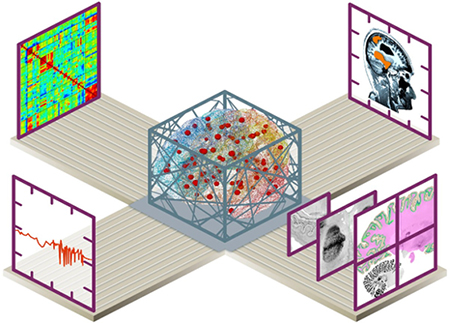- Press Release
“The beginning of a new paradigm for understanding the brain”
14 March 2022
In a new article published in eNeuro, fifteen leading scientists of the European Human Brain Project (HBP) outline how a new culture of collaboration and an era of digitalization has transformed neuroscience research over the last decade.
“The way we study the brain has changed fundamentally in recent years,” says first author Katrin Amunts, HBP Scientific Director, Director of the C. and O. Vogt-Institute of Brain Research, Düsseldorf and Director at the Institute of Neuroscience and Medicine at Research Centre Jülich. “In the past, separate communities have often focused on specific aspects of neuroscience, and the problem was always how to link the different worlds, for example, in order to explain a certain cognitive function in terms of the underlying neurobiology.”
The HBP has brought together communities from different disciplines and countries to work collaboratively on common goals. In the eNeuro article, the HBP researchers outline their scientific approach and illustrate the potential of the EBRAINS research infrastructure for neuroscience research.
The human brain is one of the most complex systems known, and many of its most basic functions are still not fully understood. There is an urgent need to gain deeper insights into the complexity of the brain in order to target mental and neurological diseases. This requires the integration of insights from multiple scales both on the spatial and temporal level. To address this challenge, the HBP has built the digital research infrastructure EBRAINS in a co-design approach between neuroscientists, developers, engineers and informaticians.
The authors highlight the increasing need for digital tools and describe how HBP scientists employ highly advanced methods from computing, neuroinformatics, simulation and artificial intelligence to carry out cutting-edge brain research. “The HBP is the first large-scale project that systematically connects brain research, medicine and information technologies,” says Viktor Jirsa, Director at the Institut de Neurosciences des Systèmes of Inserm and Aix-Marseille University and last author of the eNeuro article. “The HBP has challenged us to think beyond the boundaries of our own laboratories and domains and has enabled us to go much further than we could have ever gone by ourselves.”
The development of neuro-inspired technologies hugely benefits form the growing body of insights into perception, plasticity and learning. In this way, brain research is becoming a key driver of technological advances in computing, artificial neuronal networks, cognitive computing and neurorobotics. “Basic neuroscience research is the rocket fuel for advances in medicine and IT,” says Jirsa.
Together with the broader neuroscience community, the authors are now drafting a position paper outlining their scientific vision for the next decade of digital brain research. Researchers across Europe are invited to contribute to the living paper that has recently been published. “We will continue to make neuroscience more open, cooperative and participatory,” says Amunts. The iving document has been published on Zenodo and can be commented on via an online form.
Publication: Katrin Amunts, Javier DeFelipe, Cyriel Pennartz, Alain Destexhe, Michele Migliore, Philippe Ryvlin, Steve Furber, Alois Knoll, Lise Bitsch, Jan G. Bjaalie, Yannis Ioannidis, Thomas Lippert, Maria V. Sanchez-Vives, Rainer Goebel and Viktor Jirsa (2022). Linking brain structure, activity and cognitive function through computation. eNeuro, ENEURO.0316-21.2022; DOI: https://doi.org/10.1523/ENEURO.0316-21.2022
Media contact
Peter Zekert
press@humanbrainproject.eu




